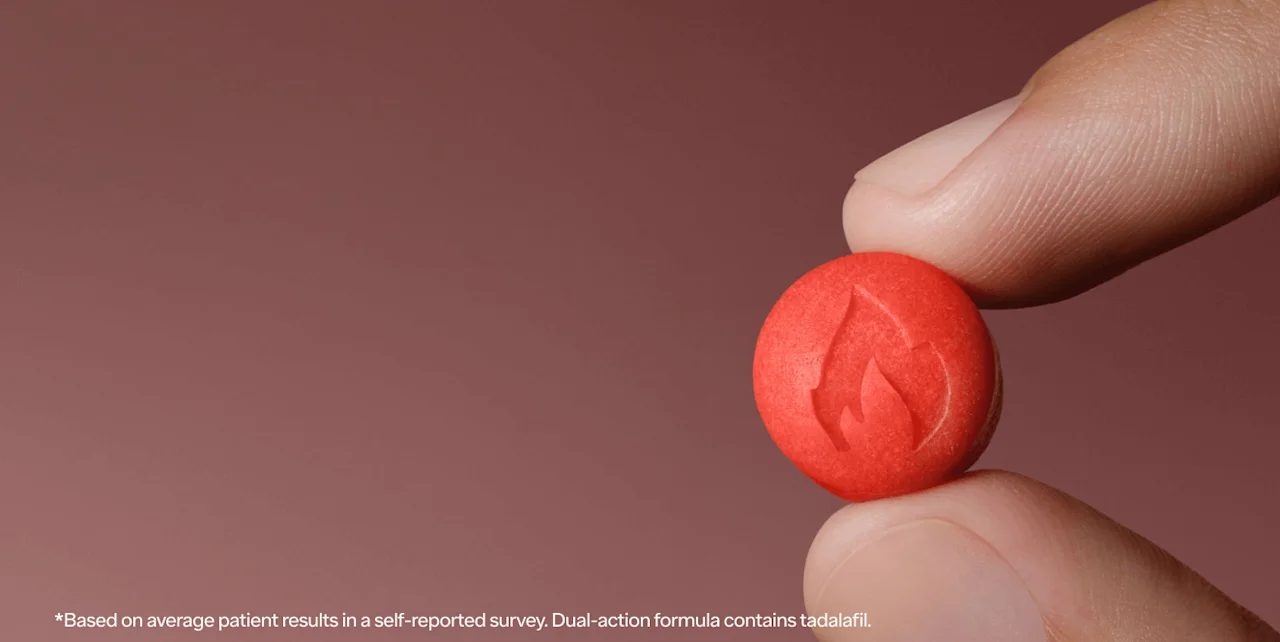Key takeaways
Viagra (sildenafil) is a prescription medication that helps treat erectile dysfunction (ED) by improving blood flow to the penis, which can make it easier to get and keep an erection during sex.
Most people start with a 50 mg dose of Viagra about an hour before sex, but your dose can be adjusted to 25 mg or 100 mg depending on how well it works for you and how your body handles it.
Viagra can be safely and discreetly obtained from Ro online, with a prescription provided through a simple virtual consultation.
Here's what we'll cover
Key takeaways
Viagra (sildenafil) is a prescription medication that helps treat erectile dysfunction (ED) by improving blood flow to the penis, which can make it easier to get and keep an erection during sex.
Most people start with a 50 mg dose of Viagra about an hour before sex, but your dose can be adjusted to 25 mg or 100 mg depending on how well it works for you and how your body handles it.
Viagra can be safely and discreetly obtained from Ro online, with a prescription provided through a simple virtual consultation.
The most common Viagra dosage is 50 mg, taken about one hour before sex. Your healthcare provider may start at a different dose or adjust to 25 mg or 100 mg based on your response. Never take more than one dose in 24 hours, regardless of strength. Talk to a provider to find the safest and most effective dose for you.
Here, we will go over the available Viagra dosages so you can talk to your healthcare provider about the right option for you.
Viagra dosage: how much Viagra can you take?

For most people, the standard starting dose of Viagra is 50 mg, but every person is different. Your dosage is set by your healthcare provider, and it can be adjusted based on your health, how you respond to the medication, and other medications you’re taking.
The good news is that Viagra offers some flexibility. You can take it anywhere from 30 minutes to 4 hours before sexual activity, depending on how your body responds to the medication, giving you plenty of time to plan. But it’s important to stick to just one dose per day, because taking more can increase your risk of side effects.
If you feel like your current dose isn’t quite right (whether it’s not working as well as you’d like or you’re experiencing side effects) talk to your healthcare provider about making adjustments.
To help with your conversation, let’s break down the main dosage options for Viagra: the typical dose, the lowest dose, and the maximum dose.
The starting Viagra dose: 50 mg
The 50 mg dose is the standard starting point for most patients. It is generally effective in helping achieve and maintain an erection for people with erectile dysfunction.
This dose strikes a balance between effectiveness and minimizing the likelihood of side effects. For many, it can provide reliable results without significant issues.
When to take it: About thirty minutes to 1 hour before you plan to have sex.
How often: No more than once per day.
If 50 mg doesn’t work well for you, speak with your healthcare provider about adjusting the dosage.
The lowest dose of Viagra: 25 mg
The 25 mg dose is ideal for people who may need a milder option due to specific factors like age, underlying health conditions, or interactions with other medications. It’s commonly prescribed for older adults, or those with liver, kidney, or cardiovascular concerns.
Who it’s for:
Adults aged 65 and older.
People with significant renal or hepatic impairments.
Those taking certain medications, like CYP3A4 inhibitors (e.g., ritonavir, erythromycin).
Starting at 25 mg may reduce the likelihood of side effects such as dizziness, headache, or low blood pressure.
The 25 mg dose can also be worth considering if you take medications that interact with Viagra. Your healthcare provider will carefully consider any medications you take when determining your optimal dose.
The maximum Viagra dose: 100 mg
The maximum recommended dose of Viagra is 100 mg, taken once within a 24-hour period. Higher doses increase the risk of side effects. Even though 100 mg is the highest Viagra dose that is usually prescribed, you should never take more than your prescribed dose on your own. Instead, talk to your provider about increasing your prescription if you feel 50 mg isn’t effective.
When to use it: Talk to your healthcare provider if the 50 mg dose isn’t effective and you can tolerate the medication well without side effects.
Your healthcare provider will determine the right dose for you based on your individual situation. Never adjust your dose without consulting them first, as the right amount depends on many factors, including your health status, other medications, and how well you tolerate the drug.
What is Viagra and how does it work?
Viagra, also known by its generic name sildenafil, is a popular medication for treating ED. It helps by increasing blood flow to the penis, which can make it easier to get and keep an erection when you’re sexually aroused.
Most people find Viagra works when taken 30 minutes to four hours before sex, and it reaches peak effectiveness around the one-hour mark. For some, it can start working in as little as 12 minutes, while others may notice it takes closer to 30 minutes.
Interestingly, Viagra was originally developed to treat chest pain, but researchers discovered it had an unexpected benefit: It was highly effective in helping people get erections.
In 1998, it became FDA-approved for ED treatment and is now available as both a brand-name drug and a more affordable generic, sildenafil.
Dosage considerations: what can affect Viagra doses?
Viagra doses for ED are usually 25 mg, 50 mg, and 100 mg. Most adults start with 50 mg, taken about an hour before sexual activity. Older adults or those with health conditions are often prescribed with 25 mg to begin with. The dose can be increased based on effectiveness and side effects.
Here's what influences Viagra doses.
Age
Age can play a significant role in how your body processes medications, including Viagra. As you get older, your metabolism slows down, and your organs - like your liver and kidneys - may not work as efficiently as they did when you were younger.
This means the medication may stay in your system longer, potentially increasing the risk of side effects like dizziness or low blood pressure.
For this reason, older adults, particularly those over 65 years old, are often prescribed a lower starting dose of 25 mg.
But even for older adults, Viagra can still be safe and effective. Studies support this approach. Research on men aged 60 to 78 showed that Viagra significantly improved erectile function, even for those over 70.
These findings highlight that age isn’t a barrier to benefiting from Viagra; it just means your dosage may need a little tailoring.
With the right dose, Viagra can help people of all ages manage ED effectively.
Kidney or liver health
Your liver and kidneys are responsible for processing and eliminating Viagra from your system. If either of these organs isn’t functioning properly, whether due to conditions like chronic kidney disease or liver impairment, it can take longer for the medication to be cleared from your body.
This can lead to higher concentrations of the drug in your bloodstream, which increases the likelihood of side effects.
For people with significant kidney or liver issues, starting at 25 mg is typically recommended. This lower dose helps ensure the medication doesn’t build up to unsafe levels while still allowing it to work.
For example, studies have shown that severe renal impairment can double the concentration of Viagra in the blood compared to someone with normal kidney function.
Starting low and monitoring closely is a safer way to manage these risks.
Other medications you’re taking
Like anything you consume, Viagra interacts with other medications, and some of these interactions can significantly impact its effectiveness or safety.
Let’s break down some key examples:
Nitrates/nitrites: This includes medications like nitroglycerin, commonly used for chest pain, and nitrites such as recreational “poppers.” They can cause a drop in blood pressure when combined with Viagra. This is because both drugs relax blood vessels, leading to an additive effect that may lower blood pressure too much. For this reason, it is typically not advisable for Viagra to be taken alongside nitrates.
Alpha-blockers: Often prescribed for urinary symptoms or prostate conditions, these medications can also lower blood pressure. When paired with Viagra, the combined effect may lead to symptoms like dizziness or fainting. To reduce this risk, healthcare providers typically start with the lowest dose of Viagra—25 mg—if you’re taking alpha-blockers.
CYP3A4 inhibitors: These medications, including some antifungals and antibiotics, can slow down how your body metabolizes Viagra. This means the medication stays in your system longer and at higher levels. In these cases, a lower starting dose of 25 mg is sometimes recommended to prevent side effects. Some healthcare providers limit the number of times Viagra should be used per week when people are also taking medications considered CYP3A4 inhibitors.
These examples highlight why it’s so important to share a complete list of your medications with your healthcare provider. Even over-the-counter drugs and supplements can sometimes interact with Viagra.
Remember that this list is not exhaustive - you should share all the medications you are taking with your healthcare provider.
Other health conditions
Certain health conditions can influence how your body reacts to Viagra, either by increasing sensitivity to the medication or by raising the risk of side effects.
Here are a few examples:
Cardiovascular conditions: Viagra works in part by relaxing blood vessels, which can lower blood pressure. While this is generally safe for most people, it can be risky if you already have a heart condition, such as a recent heart attack or severe coronary artery disease.
In some cases, your healthcare provider may recommend avoiding Viagra altogether or using it with extra caution. Some people with cardiovascular conditions have not been cleared for sexual activity whatsoever, so make sure you discuss significant changes to your routine with your healthcare provider.
Conditions that predispose to priapism: Some medical conditions, like sickle cell anemia, leukemia, or multiple myeloma, can make you more likely to develop priapism (a painful erection lasting longer than 4 hours). Since priapism can cause permanent damage if untreated, a lower dose and close monitoring of ED medication are usually recommended for people with these conditions.
Kidney or liver issues: These may slow how your body processes Viagra, leading to stronger effects or side effects.
Your healthcare provider will help determine if Viagra is a good fit for you based on your health and needs.
Food and timing
What you eat can also play a role in how Viagra works. While the medication is effective whether taken with or without food, a high-fat meal can slow down how quickly it takes effect.
For example, eating a heavy meal like a cheeseburger and fries may delay the onset of the medication by about an hour. If you want quicker results, consider taking Viagra on an empty stomach or after a lighter meal.
Timing is another key factor. While Viagra can be taken anywhere from 30 minutes to 4 hours before sexual activity, most people find it works best when taken about 1 hour in advance.
But keep in mind that sexual stimulation is still required for the medication to work—it’s not an automatic switch.
Your response to the medication
Everyone’s body processes medication differently, and Viagra’s effects can vary from person to person. While the usual starting dose of 50 mg is effective for many, it might need to be adjusted based on how your body reacts.
The goal isn’t to push for the highest dose possible. Instead, your healthcare provider will work to find the lowest dose that provides the desired effects while minimizing any side effects.
By keeping your provider informed about how Viagra is working for you, they can make adjustments to ensure your dosage is safe, effective, and tailored to your needs. Here’s more safety information on Viagra doses.
Viagra dosage by weight
Viagra dosage is not based on body weight. Instead, it depends on your age, health, and how you respond to the medication. Weight may indirectly affect dosage through its impact on metabolism and circulation. Always follow your healthcare provider’s guidance to find the safest and most effective dose.
These factors are considered by your healthcare provider when recommending the most effective and safest dose for you. Exceeding the prescribed dose may not improve its effectiveness and may increase the risk of side effects.
Viagra dosage by age
Age is an important factor when determining the right Viagra dosage, as the way your body processes medication can change over time. Adults over the age of 65 may require adjustments to ensure the medication is both safe and effective.
While the standard starting dose of 50 mg is suitable for most people, those older than 65 may benefit from a lower dose, depending on their unique health profile and tolerance.
Viagra dosage for 30-year-olds
For people in their 30s, the standard starting dose of 50 mg can be sufficient to treat ED. At this age, your body is typically able to process the medication efficiently, and adjustments to the dose are rarely needed unless side effects occur or the desired effects are not achieved.
In such cases, a healthcare provider may increase the dose to 100 mg or reduce it to 25 mg based on individual response.
Viagra dosage for 50-year-olds
People in their 50s may notice changes in how their bodies process medications, though many can still effectively use the standard 50 mg dose.
If other health conditions, such as high blood pressure or diabetes, are present, a healthcare provider may start with a lower dose of 25 mg to minimize side effects.
This cautious approach ensures the medication remains safe while still addressing ED. For those without significant health concerns, the dosage may remain at 50 mg or increase to 100 mg if needed.
Viagra dosage for 60-year-olds
By the time people reach their 60s, factors like slower metabolism, reduced kidney function, and increased likelihood of chronic health conditions can influence Viagra dosage.
For this age group, healthcare providers often recommend starting with a 25 mg dose to minimize the risk of side effects.
This lower dose provides a safer starting point while still being effective in many cases. If it’s well-tolerated, the dose can be adjusted to 50 mg or 100 mg based on your needs and response to the medication.
Regardless of age, it’s important to consult your healthcare provider to determine the safest and most effective Viagra dosage for your situation.
Your healthcare provider will consider not only your age but also your overall health and any other medications you may be taking.
Viagra side effects and risks
Like many FDA-approved medications, Viagra can cause some side effects. While most are mild and temporary, it’s important to know what to expect and when to get help.
Common side effects
Some side effects are fairly common and usually go away within a few hours, including:
Headaches
Flushing (warmth or redness in the face or chest)
Upset stomach or indigestion
Stuffy nose
Certain changes in vision, such as sensitivity to light or seeing colors differently
Higher doses are more likely to cause these effects. If you notice any of these, talk to your healthcare provider. They can help adjust your dose to minimize side effects while keeping the medication effective.
Rare side effects
Less common but more serious side effects include:
Chest pain
Feeling faint or lightheaded
Very low blood pressure
Viagra can lower blood pressure, so if you already have low blood pressure or take medication for high blood pressure, you should discuss this with your healthcare provider before using Viagra.
In rare cases, Viagra can cause:
Priapism: A painful erection that doesn’t go away. If your erection lasts longer than four hours, seek medical attention immediately to avoid damage to the penis.
Sudden vision or hearing loss: If you experience sudden changes in your ability to see or hear, it’s crucial to get medical help right away.
Sexual activity can strain your heart and may not be safe if you have a history of heart conditions or heart disease. If you have high blood pressure, it may still be safe to take Viagra, but your healthcare provider may suggest checking your blood pressure or adjusting your dosage if necessary.
Bottom line
Viagra is a reliable and effective way to treat ED, and can help many people get and keep an erection when they need it.
The best Viagra dosage depends on factors like your age, overall health, and any medications you’re taking, but options like 25 mg, 50 mg, and 100 mg make it flexible to suit different needs.
Using Viagra the right way—taking it at the right time, sticking to one dose per day, and following your healthcare provider’s advice—can help you enjoy your sex life again.
If you’re looking for more convenient options, Ro has you covered with treatments like generic sildenafil, brand-name Viagra, and Ro Sparks, a dissolvable tablet that combines sildenafil and tadalafil for fast and long-lasting effects.
Finding the right ED treatment can make a meaningful difference in your overall quality of life, helping you feel more at ease and in control.
Frequently asked questions (FAQs)
What should you do if Viagra is not working for you?
If Viagra doesn’t seem to be working as expected, don’t worry; there are several steps you can take to optimize its effectiveness. Many factors can influence how your body responds to the medication, and sometimes small adjustments can make a big difference.
Try it again: Sometimes, your body needs a few attempts to adjust to the medication. Many healthcare providers recommend trying Viagra at least a few times before deciding it’s not effective for you.
Check your timing: The best time to take Viagra is 30 minutes to four hours before sexual activity. Taking it too early or too late can affect how well it works. You can try taking Viagra on a day you don’t have partnered sexual activity planned to check your body’s natural response.
Avoid heavy meals: Taking Viagra after a large or high-fat meal can slow down how quickly it starts working. To see if this improves results, try taking it on an emptier stomach.
Limit alcohol intake: Drinking too much alcohol can interfere with Viagra’s effectiveness and make it harder to get an erection. If you drink large amounts (15 or more drinks per week for men), you might want to consider cutting back on this to prevent drops in blood pressure and preserve your erectile health. Consuming one or two standard drinks weekly may be okay, but always consult your healthcare provider for personalized guidance based on your specific health situation.
Make sure you’re sexually stimulated: Viagra doesn’t cause arousal on its own—it works by improving your body’s natural response to sexual stimulation. Being in the right mood and setting can make a big difference.
If you’ve tried these adjustments and still aren’t seeing results, consult your provider. They may adjust your dosage or suggest alternative treatments that are better suited to your needs.
How often can you take Viagra?
Viagra is designed to be taken as needed, not on a daily schedule. The key rule is to take it no more than once in a 24-hour period. Exceeding this limit increases the risk of side effects, regardless of what your prescribed dose is - whether it’s 25 mg, 50 mg, or 100 mg.
Potential side effects of taking too much Viagra include headaches, flushing, and in less common and more serious cases dizziness, low blood pressure, or priapism (a prolonged and sometimes painful erection lasting more than four hours). To avoid these risks, always stick to your prescribed dose and recommended timing.
Viagra usually begins working 30 minutes to 1 hour after taking it and remains effective for up to 4 hours. However, sexual stimulation is required for the medication to work…it won’t cause an erection on its own.
You can take Viagra with or without food. However, avoid eating high-fat meals before taking the pill–research suggests fatty foods may impact how your body absorbs the medication, causing it to take longer to work.
If you feel your current dose isn’t effective or the effects don’t last long enough, consult your healthcare provider. They can adjust your prescription to better meet your needs or consider prescribing another kind of PDE5 inhibitor for you to try.
While Viagra is safe to take long-term, there are other options you can consider for daily treatment. Daily Rise Gummies, for example, contain 7 mg of tadalafil (the active ingredient in Cialis). They can help you maintain the ability to get and keep an erection without having to plan your medication around sexual activity. While the gummies are not specifically FDA-approved, their active ingredient has been FDA approved for the treatment of ED.
Alternatively, low-dose Cialis pills, available in 2.5 mg or 5 mg doses, are another option for those who prefer daily treatment for long-term use.
What should you do if you take too much Viagra?
Accidentally taking too much Viagra can lead to serious side effects and should be addressed promptly. While Viagra (sildenafil) is generally well-tolerated, exceeding the recommended dosage increases the risk of side effects and complications.
Taking more than the recommended dose of Viagra can lead to symptoms such as:
Severe nausea or vomiting
Blurred or abnormal vision
Headache or dizziness
Rapid or irregular heartbeat
Prolonged erection that may last more than 4 hours
In extreme cases, an overdose may strain your heart or lead to low blood pressure.
All of these cases require immediate medical attention.
If you think you’ve taken too much Viagra, contact a healthcare professional or go to the nearest emergency room right away. Prompt medical attention is crucial, even if you’re not experiencing severe symptoms yet.
How much Viagra should I take the first time?
Most adults start with 50 mg of Viagra, taken about an hour before sex. Adults over 65 or with health conditions often start with 25 mg. Your dose may be raised to 100 mg if needed and if it is expected to be well-tolerated. Always follow your healthcare provider’s advice to find the right dose for you.
Never take more than one dose within 24 hours, as this can increase the risk of side effects.
How does age affect Viagra dosage?
If you’re over 65, your healthcare provider may recommend starting with a lower dose of 25 mg. As we age, our bodies can process medications more slowly, which may increase the likelihood of side effects at higher doses.
Starting with a lower dose helps with safety while still offering effective results. If the 25 mg dose isn’t sufficient, your provider may adjust it as needed.
What is the dosage of Cialis vs. Viagra?
Cialis and Viagra are both effective treatments for ED, but their dosages and how long they last differ.
Viagra is typically prescribed in doses of 25 mg, 50 mg, or 100 mg, taken as needed about an hour before sexual activity, with effects lasting up to 4 hours.
Cialis, on the other hand, is available in daily (or as-needed) doses of 2.5 mg or 5 mg, or in as-needed doses of 10 mg and 20 mg.
The as-needed doses of Cialis should be taken at least 30 minutes before sexual activity and can last up to 36 hours.
If you’re looking for an alternative, Ro Sparks combines the active ingredients found in both Viagra and Cialis and can start working in as little as 15 minutes. While Ro Sparks is not specifically FDA approved, its active ingredients are individually FDA approved for the treatment of ED.
The choice between Cialis or Viagra depends on your lifestyle and how often you plan to have sex. Talk to your healthcare provider about which option is best for you.
Here’s a guide for more safety information on Cialis.
DISCLAIMER
If you have any medical questions or concerns, please talk to your healthcare provider. The articles on Health Guide are underpinned by peer-reviewed research and information drawn from medical societies and governmental agencies. However, they are not a substitute for professional medical advice, diagnosis, or treatment.
Viagra Important Safety Information: Read more about serious warnings and safety info.
Cialis Important Safety Information: Read more about serious warnings and safety info.
References
Eardley, I., Ellis, P., Boolell, M., et al. (2002). Onset and duration of action of sildenafil for the treatment of erectile dysfunction. British Journal of Clinical Pharmacology, 53 Suppl 1(Suppl 1), 61S–65S. doi: 10.1046/j.0306-5251.2001.00034.x. Retrieved from https://pmc.ncbi.nlm.nih.gov/articles/PMC1874251/
Fujisawa, M. & Sawada, K. (2004). Clinical efficacy and safety of sildenafil in elderly patients with erectile dysfunction. Archives of Andrology, 50(4), 255–260. doi: 10.1080/01485010490448589. Retrieved from https://pubmed.ncbi.nlm.nih.gov/15277003/
Goldstein, I., Burnett, A. L., Rosen, R. C., et al. (2019). The Serendipitous Story of Sildenafil: An Unexpected Oral Therapy for Erectile Dysfunction. Sexual Medicine Reviews, 7(1), 115–128. doi: 10.1016/j.sxmr.2018.06.005. Retrieved from https://pubmed.ncbi.nlm.nih.gov/30301707/
Kloner, R. A. (2000). Cardiovascular risk and sildenafil. The American Journal of Cardiology, 86(2A), 57F–61F. doi: 10.1016/s0002-9149(00)00895-x. Retrieved from https://pubmed.ncbi.nlm.nih.gov/10899281/
Matheeussen, V., Maudens, K. E., Anseeuw, K., et al. (2015). A Non-Fatal Self-Poisoning Attempt with Sildenafil. Journal of Analytical Toxicology, 39(7), 572–576. doi: 10.1093/jat/bkv071. Retrieved from https://pubmed.ncbi.nlm.nih.gov/26139313/
Nichols, D. J., Muirhead, G. J., & Harness, J. A. (2002). Pharmacokinetics of sildenafil after single oral doses in healthy male subjects: absolute bioavailability, food effects and dose proportionality. British Journal of Clinical Pharmacology, 53(Suppl 1), 5S–12S. doi: 10.1046/j.0306-5251.2001.00027.x. Retrieved from https://pmc.ncbi.nlm.nih.gov/articles/PMC1874258/
Shi, S. & Klotz, U. (2011). Age-related changes in pharmacokinetics. Current Drug Metabolism, 12(7), 601–610. doi: 10.2174/138920011796504527. Retrieved from https://pubmed.ncbi.nlm.nih.gov/21495970/
Smith, B. P. & Babos, M. (2023). Sildenafil. StatPearls. Retrieved on Mar. 31, 2025 from https://www.ncbi.nlm.nih.gov/books/NBK558978/
U.S. Food and Drug Administration (FDA). (2018). Cialis (tadalafil) tablets, for oral use: Highlights of prescribing information (Initial US approval: 2003). Retrieved from https://www.accessdata.fda.gov/drugsatfda_docs/label/2018/021368s030lbl.pdf
U.S. Food and Drug Administration (FDA). (2017). Highlights of prescribing information: Viagra (sildenafil citrate) tablets for oral use. Retrieved from https://www.accessdata.fda.gov/drugsatfda_docs/label/2017/020895s048lbl.pdf













